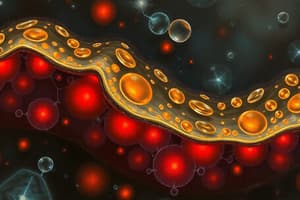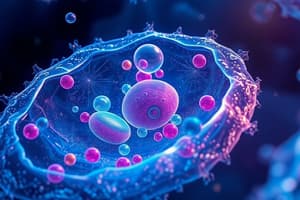Podcast
Questions and Answers
What is the primary fluid medium of the cell?
What is the primary fluid medium of the cell?
- Water (correct)
- Proteins
- Lipids
- Electrolytes
The nucleus of a cell is surrounded by the cytoplasm.
The nucleus of a cell is surrounded by the cytoplasm.
False (B)
What term is used to refer to the substances that make up a cell?
What term is used to refer to the substances that make up a cell?
Protoplasm
The main storehouse of energy in the body is ________.
The main storehouse of energy in the body is ________.
Match the following substances with their composition in the cell:
Match the following substances with their composition in the cell:
Which type of proteins are divided into structural proteins and functional proteins?
Which type of proteins are divided into structural proteins and functional proteins?
Electrolytes are the only ions present within cells.
Electrolytes are the only ions present within cells.
What are the two essential types of lipids mentioned in relation to the cell?
What are the two essential types of lipids mentioned in relation to the cell?
What is the primary purpose of studying human physiology?
What is the primary purpose of studying human physiology?
The human body consists of approximately 100 million cells.
The human body consists of approximately 100 million cells.
What do negative feedback mechanisms do in the body?
What do negative feedback mechanisms do in the body?
The human body is made up of cells, tissues, ____ , organs, and systems.
The human body is made up of cells, tissues, ____ , organs, and systems.
Which of the following is an example of a control mechanism in the human body?
Which of the following is an example of a control mechanism in the human body?
Match the following physiological functions with their corresponding control systems:
Match the following physiological functions with their corresponding control systems:
Cell reproduction occurs in almost all types of cells in the human body.
Cell reproduction occurs in almost all types of cells in the human body.
What is an example of regulation in the human body mentioned in the content?
What is an example of regulation in the human body mentioned in the content?
What is the primary purpose of pulmonary ventilation?
What is the primary purpose of pulmonary ventilation?
Positive feedback mechanisms lead to increased stability within the body.
Positive feedback mechanisms lead to increased stability within the body.
What is the term used for the process by which organisms maintain internal stability?
What is the term used for the process by which organisms maintain internal stability?
The mechanism that initiates a response to correct an excessive or deficient factor is called ________ feedback.
The mechanism that initiates a response to correct an excessive or deficient factor is called ________ feedback.
Match the following examples with their feedback mechanisms:
Match the following examples with their feedback mechanisms:
Which of the following scenarios is an example of positive feedback?
Which of the following scenarios is an example of positive feedback?
Homeostatic regulation involves maintaining systems within a cell.
Homeostatic regulation involves maintaining systems within a cell.
What could be a negative consequence of positive feedback mechanisms?
What could be a negative consequence of positive feedback mechanisms?
What is the primary function of ribosomes attached to the granular endoplasmic reticulum?
What is the primary function of ribosomes attached to the granular endoplasmic reticulum?
Lysosomes contain oxidase enzymes that assist in digestion.
Lysosomes contain oxidase enzymes that assist in digestion.
What substance is known as the 'powerhouse' of the cell?
What substance is known as the 'powerhouse' of the cell?
The Golgi apparatus processes substances into forms like ________ and secretory vesicles.
The Golgi apparatus processes substances into forms like ________ and secretory vesicles.
Which type of endoplasmic reticulum has no attached ribosomes?
Which type of endoplasmic reticulum has no attached ribosomes?
The nucleus contains ribosomes that synthesize RNA.
The nucleus contains ribosomes that synthesize RNA.
Match the organelles with their functions:
Match the organelles with their functions:
What process allows very large particles to enter the cell?
What process allows very large particles to enter the cell?
What percentage of the total mass of a cell is made up of carbohydrates?
What percentage of the total mass of a cell is made up of carbohydrates?
The fatty acid portion of phospholipid molecules is hydrophilic.
The fatty acid portion of phospholipid molecules is hydrophilic.
What is the primary role of carbohydrates in cells?
What is the primary role of carbohydrates in cells?
The outer surface of the cell membrane is composed of __________ phospholipid molecules.
The outer surface of the cell membrane is composed of __________ phospholipid molecules.
What type of proteins form channels through the cell membrane?
What type of proteins form channels through the cell membrane?
Match the following components of the cell membrane with their description:
Match the following components of the cell membrane with their description:
The cholesterol content in the cell membrane is higher than that of phospholipids.
The cholesterol content in the cell membrane is higher than that of phospholipids.
What role do the membrane carbohydrates play in cells?
What role do the membrane carbohydrates play in cells?
Flashcards are hidden until you start studying
Study Notes
Homeostasis and Cell Physiology
- Homeostasis is the self-regulating process that maintains internal stability while adapting to external changes.
- Homeostatic regulation involves systems within the cell to keep its environment stable.
Cell Structure and Composition
- The basic living unit of the body is the cell, comprising nucleus and cytoplasm.
- Protoplasm consists of water, electrolytes, proteins, lipids, and carbohydrates.
- Water constitutes 70-85% of cell content, forming a solvent for cellular chemicals.
Key Components of Protoplasm
- Ions: Key ions include potassium, magnesium, phosphate, and bicarbonate, essential for cellular function.
- Proteins: Represent 10-20% of cell mass, divided into structural and functional proteins.
- Lipids: Phospholipids and cholesterol form only about 2% of total cell mass, essential for membrane structure and energy storage.
- Carbohydrates: About 1% of cell mass, mainly in the form of glucose for energy availability.
Cell Membrane Structure
- Composed of proteins (55%), phospholipids (25%), cholesterol (13%), and carbohydrates (3%).
- The lipid bilayer allows selective permeability; hydrophilic phosphate heads face the water, while hydrophobic fatty acids are inward.
Membrane Proteins
- Integral proteins: Form channels for water and soluble substances.
- Peripheral proteins: Often enzymes, assist in transport across the membrane.
Membrane Carbohydrates
- Glycoproteins and glycolipids contribute to the glycocalyx, influencing cell recognition, signaling, and immunity.
Cellular Organelles
- Endoplasmic Reticulum:
- Granular (rough) ER is involved in protein synthesis due to ribosome attachment.
- Agranular (smooth) ER synthesizes lipids.
- Golgi Apparatus: Processes and packages substances from the ER into vesicles.
- Lysosomes: Contain hydrolytic enzymes for intracellular digestion, including damaged structures and foreign particles.
- Peroxisomes: Contain oxidases for detoxifying substances.
- Mitochondria: Known as the “powerhouses” of the cell, they generate ATP through energy extraction from nutrients.
Nucleus and Cellular Control
- The nucleus acts as the control center, housing DNA that contains genetic information.
Feedback Systems
- Negative Feedback: Maintains balance, e.g., increased pulmonary ventilation reduces carbon dioxide concentration.
- Positive Feedback: Amplifies change in the same direction, seen in processes like blood clotting and childbirth.
Importance of Physiology
- Understanding physiology aids in diagnosing and treating disturbances in normal biological functions.
Studying That Suits You
Use AI to generate personalized quizzes and flashcards to suit your learning preferences.




